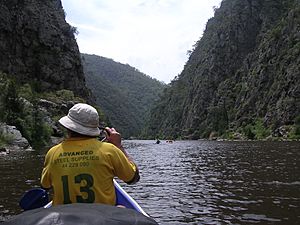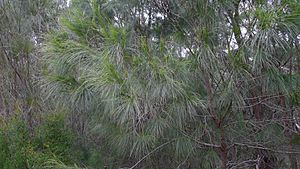Bungonia National Park facts for kids
Quick facts for kids Bungonia National ParkNew South Wales |
|
|---|---|
|
IUCN Category II (National Park)
|
|

The view from Bungonia Lookdown of the Bungonia Gorge.
|
|
| Nearest town or city | Goulburn |
| Established | 21 May 2010 |
| Area | 15 square kilometres (5.8 sq mi) |
| Managing authorities | NSW National Parks and Wildlife Service |
| Website | Bungonia National Park |
| See also | Protected areas of New South Wales |
Bungonia National Park is a special protected area in New South Wales, Australia. It's about 40 kilometers (25 miles) east of Goulburn. Sydney is about 122 kilometers (76 miles) to the south-west. This park covers about 15 square kilometers (5.8 square miles).
The park is next to the Bungonia State Conservation Area. It also borders Morton National Park and Bungonia Creek. Bungonia became a national park in 2010. Before that, it was a water reserve since the late 1800s. This protected the water for the Shoalhaven River.
The NSW National Parks and Wildlife Service (NPWS) looks after the park. They maintain campgrounds and walking trails. Bungonia is famous for its many caves and deep gorges. These offer exciting chances for climbing and canyoning. It's also part of a chain of national parks. These parks stretch along the Great Dividing Range in central NSW.
Contents
History of Bungonia National Park
Bungonia National Park is on the traditional lands of several Aboriginal groups. These include the Njunawal, Wandandian, and Gandangara peoples. The high ridges were important travel routes for tribes. They moved with the seasons to gather food. Old campsites have been found on the main plateau. There are also limestone dolines (sinkholes) with remains of plants. These plants were eaten by Aboriginal people long ago.
Early European Exploration
The first European visitors came in 1798. They were led by H. Hacking. European settlement in this area began around the 1820s. The town of Goulburn was settled in the 1840s. The town of Bungonia was planned in 1832. In 1838, Governor George Gipps visited the park. He walked to the lookout now called Bungonia Lookdown.
The area became a water reserve in 1872. This was to protect the water supply from the Shoalhaven River. In the same year, people explored the Drum Cave and Sky-Light Cave. The Drum Cave was named for the sound a stalactite made when hit. The Sky-Light Cave had a large hole in its roof. More explorations of the caves happened in the late 1800s.
Growing Popularity and Protection
Visitor records for the park started in 1892. That year, 85 visitors were counted. By 1899, this number grew to 559. Exploring the caves cost 15 pounds per group, and "candlesticks were provided."
In 1902, more land was protected. This was to save the fragile limestone rock formations and caves. Louis Guymer was the park's caretaker from 1889 to 1909. He found and recorded many of the park's caves. Guymer also built gates and ladders. These still help people access the cave networks and climbing routes today.
Protecting the Park from Mining
In the 1970s, there were disagreements about the land. The NSW government, conservation groups, and mining companies were involved. Mining companies wanted to quarry large amounts of limestone. This was in Bungonia Gorge from 1972 to 1974. Groups like the Bungonia Committee pushed the government. They provided reports on the geology and environment. This led to the creation of the Bungonia State Conservation Area in July 1974. Later, the northern part of this reserve became a national park.
Unique Geology of Bungonia
Bungonia National Park has very unique geology. It's known as the "adventure capital of the Southern Tablelands." The park has over 200 caves. It also has many gorges and canyons. The rock formations here are part of the Lachlan Fold Belt. This area has old ordovician and devonian sandstones, shales, and volcanic rocks. These rocks are rich in minerals. They are part of a larger area that has important gold deposits.
The geology of Bungonia is mostly fine-grained sedimentary rock. There are also some small areas of volcanic rock and limestone. A wide, dry plateau covers much of the park. Many cliffs and gorges are found near waterways. These include the Shoalhaven River and Bungonia Creek. The caves and cracks in the park are formed by a process called karstification. This is common in limestone areas.
Limestone and sandstone are the main rock types seen on the surface. The Bungonia Gorge and Bungonia slot canyon run through the park. These formations show the sedimentary and volcanic activity that shaped the park. The soil in Bungonia is mostly shallow, organic loam. It lies on top of limestone and basalt plates. These form the main plateau.
Plants and Animals
Flora (Plants)
Bungonia National Park has many different plants. Most species are found throughout the Southern Tablelands region. The park has broad-leaved peppermint (Eucalyptus dives) and white gum (Eucalyptus wandoo). You can also find grass trees (xanthorrhoea) and red stringybark (Eucalyptus macrorhyncha). Large areas are covered by black ash (Eucalyptus sieberi) forest. Eucalyptus trees are common, especially on the main plateau.
In colder parts of the park, snow gum (Eucalyptus pauciflora) and snow grass (Poa sieberiana) grow well. This is especially true in winter. Like much of the southern Great Dividing Range, black she-oak (allocasuarina littoralis) is common. It grows in lower areas and places where new plants are growing. There is also some argyle apple (Eucalyptus cinerea). This tree is known for its soft blue leaves.
Fauna (Animals)
Many animals live in Bungonia National Park. They are found throughout the South Eastern Highlands. Eighty-eight species live in the park. Sixty-three of these are vulnerable, and twenty-five are endangered. Dozens of bird species are found here. Many lookouts are great spots for bird-watching.
Birds that visit Bungonia National Park include:
- gang-gang cockatoo
- butcher bird
- noisy miner
- glossy black cockatoo
- swift parrot
- common cockatoo
- hooded robin
- square tailed kite
- kookaburra
The number of smaller woodland birds has gone down since the late 1900s. At the same time, butcher-bird, noisy miner, and common-myna populations have grown. Other animals in the park include the vulnerable large bent-wing bat. These bats breed in many caves during cooler months. You can also find Monitor lizards, echidnas, wombats, wallabies. Small groups of koalas and spotted-tail quolls also live in the park.
Climate and Environmental Challenges
In summer, the average temperature in Bungonia National Park is between 12 and 26 degrees Celsius (54-79°F). The highest temperature recorded was 40 degrees Celsius (104°F). Because it's high up and inland, the park has very cool winters. The average winter temperature is between 1 and 14 degrees Celsius (34-57°F). The lowest temperature ever recorded was -9 degrees Celsius (16°F). The park gets about 665 millimeters (26 inches) of rain each year. Most rain falls in March, and the least in September. The most rain in one day was 200.7 millimeters (7.9 inches).
Environmental issues mainly affect koalas and spotted-tail quolls. Both are endangered because their homes are being destroyed. Also, feral animals are a problem. NSW Parks has been running programs to control feral animals since 2005.
Small woodland birds, like the hooded robin and varied sittella, are also at risk. Their habitats are being destroyed by mining projects nearby. Larger native and non-native birds are taking over these areas. They are slowly pushing out the smaller, less hardy species. The threatened large bent-wing bat uses caves in the park for mating and hibernating. Because of this, NPWS often closes the Drum and Grill caves. This helps protect the bats during their important breeding season.
A large limestone quarry is operated by Boral Limited just north of Bungonia Gorge. This quarry has raised concerns about protecting the important geology. Water runoff from the quarry can harm local water sources. Also, clearing land and the resulting erosion threaten parts of the gorge. It also affects the eucalypt forest on the surrounding hills. The quarry was supposed to close in 2011. However, in 2015, Boral Limited asked for a 30-year extension. They are currently filling in the southern part of the pit. They are also planting native trees in their work areas. Meanwhile, they continue to quarry the northern section.
Park Activities
Caving is a very popular activity in the park. Hundreds of caves are open to explore all year. Many caves can be reached using ladders or anchored ropes. This makes them usable for both experienced and new cavers. Some of the larger caves include the Drum Cave and Grill Cave. Other caves are Blowfly Cave, Argyle Cave, Chalk Cave, College Cave, Canberra Hole, Fossil Cave, and Spider Cave. There are also dozens of unnamed caves. Sometimes, dangerous levels of CO2 gas can be found in these caves, especially in summer.
There are five main hiking trails in the park. They are called the Yellow Track, Green Track, Red Track, White Track, and Orange Track. An access road connects many of these tracks to the main office and visitor center. Adams Lookout, Jerrara Lookout, and Bungonia Lookdown offer great views. From these spots, you can see the gorges and valleys around the plateau. The park has three picnic areas and one camping area. All are managed by NPWS and are open to the public.
Bungonia Slot Canyon is great for bouldering (climbing on rocks without ropes) and harnessed line climbing. It offers some of the only limestone climbing in Australia.







